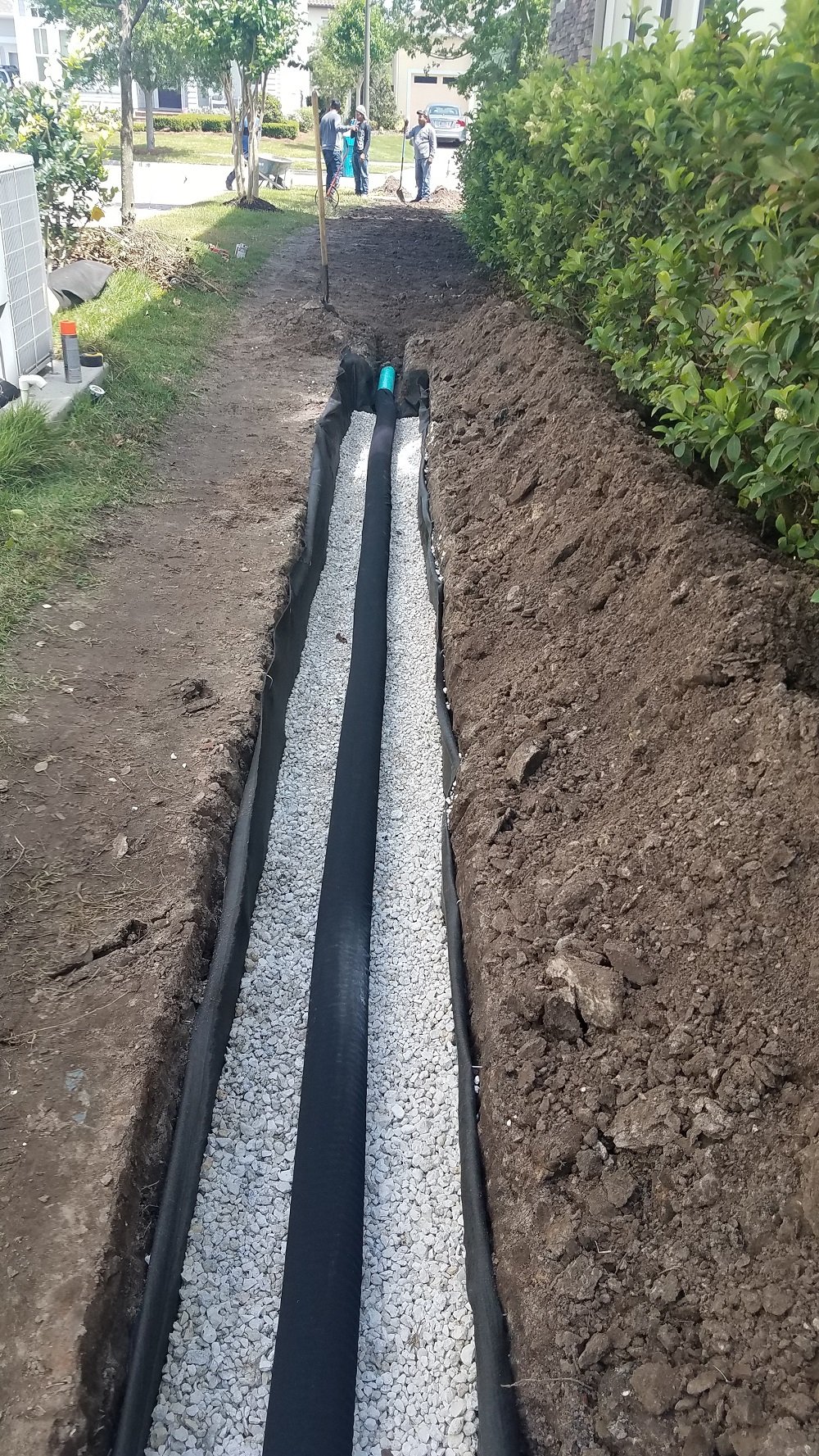The Necessary Overview to Preserving Your French Drainpipe for Long-Lasting Performance
Maintaining your French drain is crucial to its efficiency and your building's protection. Regular checks can conserve you from costly fixings and water damage. You'll would like to know what indicators to search for and just how often to evaluate your system. And also, comprehending the cleansing process can make a significant difference. Allow's discover the important actions for ensuring your drain functions well for several years to find.
Recognizing the Feature of a French Drain
A French drain is a critical element in handling water around your home. It routes excess water away from your foundation, stopping flooding and damages. When hefty rain falls, the drain collects water through a perforated pipe buried in gravel. This system allows water to move openly, minimizing pressure on your basement wall surfaces and reducing the risk of leaks.You may question how it operates in method. As water saturates the soil, gravity pulls it toward the drain. The perforated pipe catches this water, carrying it to a designated water drainage area or tornado sewage system. This process keeps your yard dry and protects your home's structural integrity.Understanding just how a French drain features is key to appreciating its importance. By effectively carrying water away, it aids keep a risk-free and dry living atmosphere. Maintaining your French drainpipe in leading problem warranties you stay clear of expensive repair work down the line.
Routine Examinations: What to Seek
When you're checking your French drainpipe, beginning by looking for any blockages that may be blocking water circulation. Pay interest to indications of surface erosion around the drainpipe, as this can show prospective problems. Routine analyses will assist maintain your drain system operating properly.
Clogged Drainpipe Assessment
How can you inform if your French drainpipe is obstructed? First, look for water pooling in your yard, specifically after heavy rainfall. That's a red flag if you observe locations where water accumulates instead of draining pipes. You need to additionally check the drainpipe electrical outlet; if water isn't moving out as it should, there's most likely an obstruction. Listen for uncommon gurgling noises, which can suggest trapped air. Furthermore, evaluate the drainpipe's surface for any type of vegetation growth, as roots can infiltrate and clog the system. Lastly, if you scent moldy smells, it might point to stagnant water brought on by a clog. Frequently examining these indicators can help you preserve your French drain effectively and stop pricey repair work.
Surface Disintegration Examine

Cleaning Your French Drainpipe: Step-by-Step Overview
Cleansing your French drain is crucial for maintaining it functioning properly. You'll require some specific devices and a clear process to assure every little thing runs smoothly. Let's go through the steps and tips for maintaining your drain successfully.
Tools You'll Require
To take on the job of cleaning your French drainpipe successfully, you'll want to gather a few crucial devices. Grab a sturdy set of handwear covers to protect your hands from debris and sharp items. A little shovel or trowel will help you get rid of dirt or obstructions around the drainpipe. For removing out the inside, a plumbing professional's serpent or a high-pressure water nozzle can be extremely helpful. You'll additionally need a bucket for accumulating any type of particles you pull out. Finally, having a garden hose available will certainly make it much easier to wash out the drainpipe and guarantee it's flowing smoothly. With these tools prepared, you'll be established for a comprehensive cleaning session!
Cleaning Process Steps
Start by assessing the location around your French drainpipe for any visible particles or blockages. Remove fallen leaves, branches, or dust that may obstruct water flow. Next, check the inlet and outlet areas; clear any type of obstructions to assure proper drain. Utilize a yard pipe to purge the drainpipe, guiding water into the inlet. This helps displace any type of built up sludge or sediment. Think about utilizing a plumbing professional's snake to damage them up if you discover consistent obstructions. After cleaning, examine the crushed rock around the drain; renew it if it's cleaned away. Lastly, confirm the drain covers are intact and firmly in location to avoid debris from getting in. Normal cleaning keeps your French drain operating efficiently.
Upkeep Frequency Tips
While routine maintenance is important for your French drain's long life, knowing exactly how typically to keep it can make all the difference. Preferably, you should inspect your French drain at the very least two times a year, ideally in springtime and loss. After hefty rains or snowmelt, check for obstructions or particles. If you notice any type of standing water, it's time to cleanse your drain.In areas with heavy foliage, even more constant maintenance-- regarding every 3 months-- might be required. Furthermore, take into consideration cleaning your French drain after major tornados or if you observe water merging in your lawn. By staying aggressive, you'll guarantee your French drain functions effectively and secures your residential property from water damage. Normal checks will certainly conserve you time and cash in the lengthy run.
Identifying Usual Issues and Their Solutions
When you see water pooling in your yard or damp places in your basement, it's important to determine typical issues with your French drainpipe and apply reliable services. One regular problem is clogging, typically triggered by particles like leaves or debris. To fix this, you can make use of a pipes serpent or a high-pressure water jet to clear blockages.Another issue could be improper incline. If your drain isn't sloped properly, water will not flow away from your home. You can adjust the incline by excavating and repositioning the drain pipe.Lastly, check for damages or cracks in the drain itself. Changing the damaged sections is vital for peak performance if you locate any kind of. By addressing these concerns quickly, you'll aid guarantee that your French drain remains to operate properly, protecting your property from water damages and maintaining a completely dry, risk-free setting.
Seasonal Upkeep Tips for Your French Drainpipe
Attending to usual problems with your French drainpipe is just the first action in guaranteeing its long-term effectiveness. Seasonal upkeep is essential for peak efficiency. In the springtime, eliminate leaves and particles that may have gathered throughout winter months. Look for any clogs in the electrical outlet or capture basin, as water needs a clear path to flow freely.During summertime, evaluate your drain for any kind of indicators of moving or settling dirt. Make specific it's still degree and working effectively. As fall techniques, tidy out any dropped entrusts to avoid obstructions prior to winter months arrives.In winter months, watch for freezing temperatures. If you reside in a chilly climate, ensure your drain isn't in jeopardy of freezing. Insulating revealed pipelines can help. Normal checks and timely maintenance can prevent costly repairs and keep your French drainpipe functioning successfully year-round. Stay aggressive and appreciate satisfaction knowing your drainage system remains in excellent shape!
When to Call an Expert
When to call in a professional can save you time and stop further damages to your French drain, recognizing. It's a clear sign that your drain might be clogged or damaged if you see persistent standing water in your backyard. Don't neglect unusual odors, as they can indicate sewage back-up or decay, which needs immediate attention.If you locate that your drainpipe isn't working appropriately after efforts to clean or keep it, it's time to connect for specialist help. Furthermore, if you're unsure about the underlying issues or lack the needed devices, employing a specialist can provide tranquility of mind.Finally, if your French drain is old or has experienced substantial deterioration, professional analysis can determine whether fixings or total replacement is needed. Trust the professionals to guarantee your water drainage system functions efficiently for years to find.
Tips for Stopping Future Water Drainage Problems
To keep your French drain working efficiently, on a regular basis inspecting and preserving it can make all the distinction. Start by getting rid of particles, leaves, and dust from the surface area and drainpipe openings. This avoids clogs that can bring about water backup. Inspect the gravel around the drain; if it's compressed or worn down, think about including fresh gravel image source to keep excellent flow.Next, divert water away from your drainpipe by making sure downspouts and seamless gutters are clear and directing water at least 3 feet away from your structure. Routinely evaluate for any type of indicators of damages or sagging. If you observe concerns, resolve them immediately.Finally, think about installing a filter or a catch basin to catch larger debris before it enters the drainpipe. By remaining proactive with these ideas, you'll minimize the danger of future water drainage issues and keep your French drainpipe in leading form.
Regularly Asked Questions
How much time Does a French Drain Commonly Last?
A French drain usually lasts around 30 to 40 years, depending upon the products made use of and upkeep (Portland French Drain). If you stay up to date with regular checks, you can Source prolong its lifespan also further
Can I Install a French Drainpipe Myself?
Yes, you can mount a French drain yourself if you've obtained the right devices and understanding. Simply ensure to plan very carefully, adhere to regional guidelines, and guarantee correct drain to prevent future concerns.
What Materials Are Used in a French Drainpipe?
You'll require perforated pipe, crushed rock, landscape fabric, and a strong drain pipe for your French drain. These products help reroute water efficiently, preventing flooding and keeping your building completely dry and safe from water damage.

Is an Authorization Required to Mount a French Drain?
You'll likely need a permit to set up a French drain, relying on regional regulations. Talk to your municipality to assure you comply with any type of necessary guidelines and prevent prospective concerns throughout installation.
What Are the Expenses Connected With French Drainpipe Maintenance?
Maintaining a French drain normally costs in between $100 and $500 annually. You'll require to take into account expenses for cleaning, fixings, and evaluations. Regular upkeep assists avoid bigger guarantees and expenditures your system works effectively for several years - Portland French Drain. When you're examining your French drain, begin by checking for any blockages that may be obstructing water circulation. By remaining proactive, you'll assure your French drain functions effectively and safeguards your residential or commercial property from water damage. When you notice water merging in your backyard or damp places in your basement, it's vital to identify common concerns with your French drain and apply effective remedies. You can adjust the incline by digging and repositioning the drain pipe.Lastly, check for damage or cracks in the drainpipe itself. Inspect the crushed rock around the drain; if it's compacted or worn down, consider including fresh crushed rock to keep excellent flow.Next, draw away water away from your drainpipe by making sure seamless gutters and downspouts are clear and directing water at the very least 3 feet away from click this link your foundation
 Heath Ledger Then & Now!
Heath Ledger Then & Now! Melissa Joan Hart Then & Now!
Melissa Joan Hart Then & Now! Shannon Elizabeth Then & Now!
Shannon Elizabeth Then & Now! Stephen Hawking Then & Now!
Stephen Hawking Then & Now! Ricky Schroder Then & Now!
Ricky Schroder Then & Now!